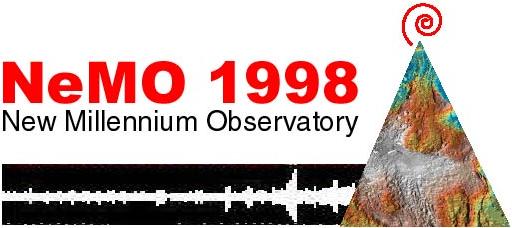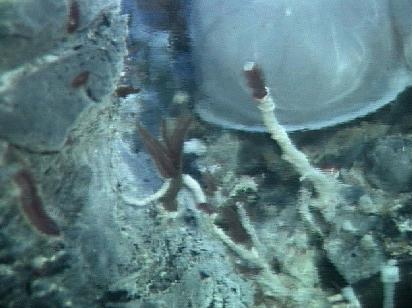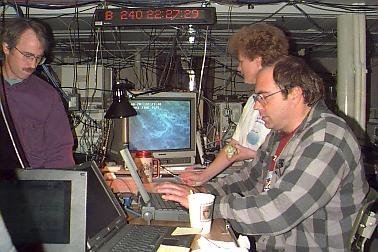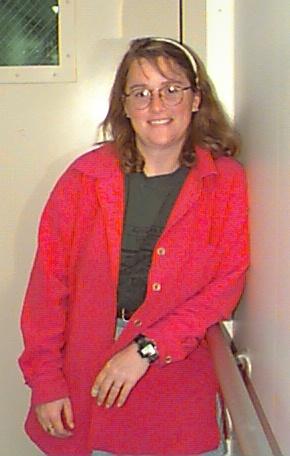WHAT'S NEW:
Other 1998 Axial Cruise Reports
(posted 8/13/98)
BACKGROUND:
Technology (ROV, ships, etc.)
Other 1998 Axial cruise reports
EXPEDITION:
Science Objectives
Calendar
Today's Science News
Participant Perspective
Teacher Logbook
EDUCATION:
Curriculum
Teacher Observations
Questions/Answers from sea
MULTIMEDIA:
(video clips, animations, sounds)

Logbook
August 29, 1998
August 29, 1998
Contents:
Science Report
Science Report-- Some Impressions after the first two ROPOS dives in Axial Caldera
Bob Embley
Chief Scientist

Tubeworms at eastern caldera wall of Axial Volcano (photo: ROPOS NeMO 1998)
This afternoon the NeMO program began its second long ROPOS dive on the eastern side of the caldera. The first dive discovered several very vigorous diffuse vents along a northwest trending fracture system. The venting fluids varied in character from very milky to clear with temperatures up to almost 40 C. Large areas were covered with white bacterial mats which also were observed covering the insides of cavities of the porous lavas. Close examination with the excellent color camera on ROPOS revealed large bacterial flocs frequently breaking off from within these shallow subsurface cavities and being carried off by bottom currents. The most vigorous venting seen to date on the eastern side is coming from a series of pits which are gushing warm fluid filled with floc. Measurements with the PMEL chemical scanner by scientists Gary Massoth and Stacey Maenner have revealed very high levels of hydrogen sulfide in these fluids.
Bill Chadwick and the NeMO navigation team successfully homed in on the missing "rumbleometer" on Saturday afternoon using acoustic ranging. ROPOS found the instrument partly embedded in a pile of loose cindery lava which apparently blocked the release hook from fully deploying. An attempt may be made later in the expedition to release the instrument by attaching a line from it to the ROPOS cage because it may very well may hold some key data that will help us understand better what the environment of the seafloor was like in the vicinity of the massive outpouring of hot water following the subseafloor magma injection.
A major question that has arisen from observations made during the first two dives is "where have all the tubeworms gone?" (see above photo taken on second dive of tubeworms at a different location). Photographs taken by a camera towed near the seafloor from the German research vessel SONNE in 1996 and by a ROPOS dive in 1997 revealed extensive areas of tubeworms along approximately the same track that ROPOS made. Considerable debate was heard in the ROPOS control center in the wee hours of last night. Did the tubeworms get covered with lava? Did an extensive outpouring of hot water clean off prexisting colonies of these animals during the January/February earthquake swarms, leaving a pristine surface to be recolonized?
Bob
 Main ROPOS laboratory (a wiring nightmare!). Computer screen in background
has live ROPOS video shot. Pictured are scientists Lee Evans & Dave Butterfield
(NOAA Vents), Verena Tunnicliffe (U. Victoria) photo: S.Merle NOAA
Main ROPOS laboratory (a wiring nightmare!). Computer screen in background
has live ROPOS video shot. Pictured are scientists Lee Evans & Dave Butterfield
(NOAA Vents), Verena Tunnicliffe (U. Victoria) photo: S.Merle NOAA
Listing of all Science News postings
Life at Sea: Participant Perspective
Betsy McLaughlin-West
Researcher, Rutgers University
 Hi all, my name is Betsy McLaughlin-West. I'm an oceanographer from Rutgers
University. I have been studying hydrothermal vent environments for the past 7
years. My main interests are the chemistry of the hydrothermal fluids and the
bacteria that use the hydrothermal chemicals as energy sources. The hot water
that comes out of the vents contains a number of chemicals that bacteria can use
for food. The main ones I have been studying are hydrogen and methane gas.
At most vents, there is a lot more hydrogen and methane gas in the hydrothermal
fluids than in the background seawater. The bacteria that can use these energy
sources can grow better in vent environments than in other parts of the ocean
(since there is more to eat around the vents). I've been trying to determine
how important hydrogen and methane (and the bacteria that use these gases) are
to the entire vent environment and the larger animals that live there.
Hi all, my name is Betsy McLaughlin-West. I'm an oceanographer from Rutgers
University. I have been studying hydrothermal vent environments for the past 7
years. My main interests are the chemistry of the hydrothermal fluids and the
bacteria that use the hydrothermal chemicals as energy sources. The hot water
that comes out of the vents contains a number of chemicals that bacteria can use
for food. The main ones I have been studying are hydrogen and methane gas.
At most vents, there is a lot more hydrogen and methane gas in the hydrothermal
fluids than in the background seawater. The bacteria that can use these energy
sources can grow better in vent environments than in other parts of the ocean
(since there is more to eat around the vents). I've been trying to determine
how important hydrogen and methane (and the bacteria that use these gases) are
to the entire vent environment and the larger animals that live there.
In order to figure these things out, I'm collecting two types of water samples on this cruise. We can sample the venting fluids directly with ROPOS (which I'm sure you'll hear more about in a later report so I'll leave it until then) and we can collect fluids from the water column above the vents with a system called a CTDT/Rossette. A CTDT is an instrument that can measure the conductivity, temperature, depth and the amount of particles in the water. It is connected to the ship with a conducting wire so you can actually have real-time access to the data it is collecting. It is attached a cage-like package that also has eleven 20 liter water bottles attached to it. The cage is lowered over the side of the ship with the bottles open. As it gets lowered through the water column we can decide where to close the bottles based on the data we are collecting with the CTDT. When the hot water from the vents comes out at the seafloor it is buoyant and rises in the water column. As it rises it mixes with the surrounding seawater until it is no longer buoyant and it begins to spread out in a layer and moves with the currents (sort of like smoke coming out of smokestack being blown by the wind). This is called the hydrothermal plume. Although the fluid has mixed with a lot of seawater by this times (10000 parts seawater to 1 part vent fluid!), it still has a slightly higher temperature and particle content then the seawater around it. The CTDT can measure those temperature and particle differences so we know when we are 'in the plume' and can close the water bottles. Not only does the plume have temperature and particle differences, it also still has more hydrogen and methane than normal seawater so it is a good place for the bacteria to hang out since there is food there!
I'm hoping to compare results from my experiments on this cruise with some I did during the February Event Response Cruise to see if there are any big differences in what is happening now versus what was going on then. Hopefully there will be lots to compare! Keep checking back to see what everyone else is up to out here!
Listing of all Perspectives postings
Teacher At Sea Logbook
August 29-0900 hours
Thank goodness the weekend is here and I can sleep in. Forget that! We're at sea. There is no weekend. There is no "middle-of-the-night." The ship lives 24 and 7, and we have jobs to do. The ROPOS came aboard late last night for repairs. The technicians have been working ever since. We are anticipating a second dive starting around 1000 hours this morning.
In the last several hours of the last dive the ROPOS concentrated on collecting the data needed to construct accurate maps of the ocean floor where we have been working. This involves the use of a sonar scanner that sweeps the ocean floor beneath the sub as the technicians steer it back and forth across the area to be mapped. There is nothing of interest on the video monitors, so this as boring as it gets at sea. Most people are using the down time to get some needed sleep.
I had the chance to sit in on the meeting of the scientific team and listen to how decisions get made. They discussed things that went right and wrong with the first dive, outlined the objectives for the second dive, and assigned responsibility for some duties that need to be covered. We've all heard the lecture that in science lab groups you are part of a team, but it's really something to see this idea in action. Compromise and cooperation are constantly in evidence. For example, there was a thorough discussion of how samples from the bottom would be handled and catalogued. There are dozens of samples of water, marine life, rock, recovered instruments and other items that must be shared among the scientists on board. The team wants to be sure that everything gets handled in the correct order, that everyone has something to work on, and that the samples be properly labeled and stored so that they can be retrieved for later study. Take notice students. These are the skills we try to teach you in class, and this is why we do it. You may not plan to be a scientist, but these are skills that we all use if we want to be successful.
It is impossible to keep all the information in your mind. Scientists carry record books and write in them frequently. In addition there is a person assigned in the lab to keep a running record of discoveries, questions, navigation information, and comments as the dive proceeds. This is in addition to the video tapes and audio commentary that also serves to remind scientists what they have seen as well as when and where they have seen it. In real estate it's "location, location, location." In science it is "accuracy, accuracy. accuracy." No one wants to contaminate the data with a poorly remembered fact or a lost sample.
1200 hours
I have been assigned to help retrieve samples of rock from the ocean floor. We lower a heavy coring device to within 20 meters of the sea floor. Then the corer is lowered at 60 meters per minute until it collides with the sea floor. There are five sampling containers attached to the tip of the corer. Each is filled with a special sticky wax that catches broken pieces of the lava that makes up the floor near the volcano. These are brought back to the ship, and we are responsible for seeing that the samples do not touch the deck or anything else while they are removed from the corer. The samples are then removed from the wax, tagged with the location where they were recovered, and shipped to labs in Florida where they will be analyzed. The scientists who are working on this part of the volcano are particularly interested in the chemical makeup of the rocks. Axial Volcano looks and acts much like a typical "hot spot" volcano. The Hawaiian Islands are formed from a hot spot. Rocks from these types of volcanoes typically show alkaline signatures and are unusually rich in some of the rare-earth elements. Up until now, rock samples from Axial have not shown these expected properties, and scientists want to know why.
0400 hours. I'm off watch. Latest score: Ocean 1, Williamson 1. We dropped the rock sampler right on target and were rewarded with some excellent samples of the basalt glass from the bottom of the ocean. I have taught about this stuff. I've even talked about doing it, but I have to tell you, nothing can compare to the real thing. ROPOS (Remotely Operated Platform for Ocean Science) is just beginning its next dive as I am preparing this report. Yes we are eight hours behind schedule, but in that eight hours we were able to grab the rock samples. We are going back into the same area as the first dive to gather data and materials with new instruments.
In the next couple of days we hope to post audio/video clips of some of the amazing things we have seen on the ocean floor. Don't miss it.
Logbook of all Teacher At Sea postings
Question/Answer of the Day
Send Your Question to NeMO
Back to Calendar